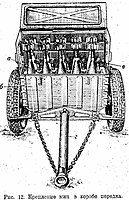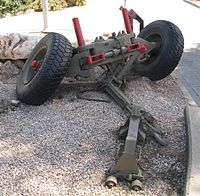
The French 75 mm field gun is a quick-firing field artillery piece adopted in March 1898. Its official French designation was: Matériel de 75 mm Mle 1897. It was commonly known as the French 75, simply the 75 and Soixante-Quinze. The French 75 was designed as an anti-personnel weapon system for delivering large volumes of time-fused shrapnel shells on enemy troops advancing in the open. After 1915 and the onset of trench warfare, impact-detonated high-explosive shells prevailed. By 1918 the 75s became the main agents of delivery for toxic gas shells. The 75s also became widely used as truck mounted anti-aircraft artillery. They were the main armament of the Saint-Chamond tank in 1918.
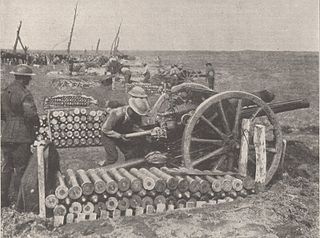
The Ordnance QF 18-pounder, or simply 18-pounder gun, was the standard British Empire field gun of the First World War-era. It formed the backbone of the Royal Field Artillery during the war, and was produced in large numbers. It was used by British Forces in all the main theatres, and by British troops in Russia in 1919. Its calibre (84 mm) and shell weight were greater than those of the equivalent field guns in French (75 mm) and German (77 mm) service. It was generally horse drawn until mechanisation in the 1930s.

Field artillery in the American Civil War refers to the artillery weapons, equipment, and practices used by the Artillery branch to support the infantry and cavalry forces in the field. It does not include siege artillery, use of artillery in fixed fortifications, or coastal or naval artillery. Nor does it include smaller, specialized artillery classified as small arms.

Horse artillery was a type of light, fast-moving, and fast-firing artillery which provided highly mobile fire support, especially to cavalry units. Horse artillery units existed in armies in Europe, the Americas, and Asia, from the early 17th to the mid-20th century. A precursor of modern self-propelled artillery, it consisted of light cannons or howitzers attached to light but sturdy two-wheeled carriages called caissons or limbers, with the individual crewmen riding on horses. This was in contrast to the rest of the field artillery, which were also horse-drawn but whose gunners were normally transported seated on the gun carriage, wagons or limbers.
A gun carriage is a frame or a mount that supports the gun barrel of an artillery piece, allowing it to be maneuvered and fired. These platforms often had wheels so that the artillery pieces could be moved more easily. Gun carriages are also used on ships to facilitate the movement and aiming of large cannons and guns. These are also used in the funeral procession of any higher authority of any state and country.

The 155 mm gun M1 was a 155 millimeter caliber field gun developed and used by the United States military. Nicknamed "Long Tom", it was produced in M1 and M2 variants, later known as the M59. Developed to replace the Canon de 155mm GPF, the gun was deployed as a heavy field weapon during World War II and the Korean War, and also classed as secondary armament for seacoast defense. The gun could fire a 100 lb (45 kg) shell to a maximum range of 14 mi (23 km), with an estimated accuracy life of 1,500 rounds.

The Canon de 12 Gribeauval or 12-pounder was a French cannon and part of the system developed by Jean Baptiste Vaquette de Gribeauval. There were 1.079 English pounds in the Old French pound, making the weight of shot nearly 13 English pounds. The 12-pounder was the heaviest cannon in the French field artillery; the others were the light Canon de 4 Gribeauval and the medium Canon de 8 Gribeauval. Superseding the previous Vallière system, the Gribeauval system was adopted in 1765 and its guns were first used during the American Revolutionary War. The greatest use of Gribeauval guns came during the French Revolutionary Wars and the Napoleonic Wars. During the latter wars, the 12-pounder was often employed in corps artillery reserves. Because of their physical and psychological effect, Emperor Napoleon increased the number of 12-pounders in his artillery and fondly called the cannons his belles filles. Gribeauval cannons fired canister shot for close-range work and round shot at more distant targets. In 1803 the Year XI system was introduced, but it only partly replaced the Gribeauval system which was not completely replaced until the Valée system was set up in 1829.

The Obusier de 6 pouces Gribeauval or 6-inch howitzer was a French artillery piece and part of a system established by Jean Baptiste Vaquette de Gribeauval. The Old French inch was 1.066 English inches long so the weapon can accurately be described as a 6.4-inch howitzer.

The 75 mm gun M1916 was a US Army field artillery piece used during and after World War I. It was used as an anti-aircraft gun as well as a field piece. It originated as the 3-inch gun M1913, which was soon modified to the 3-inch gun M1916, which was later altered to the subject weapon.

The K-4 cart is a 2-wheel strongly constructed signal cart similar to artillery caissons, but equipped for carrying signal equipment; used with the Wire cart, type K-3, to form the wagon formerly called "Pintle wire wagon, M1910".

The Obusier de 120 mm modèle 1915 Tir Rapide or quick loading 120 mm Howitzer Model 1915 was a French howitzer designed and built by the Schneider company and used by a number of nations during the First World War.
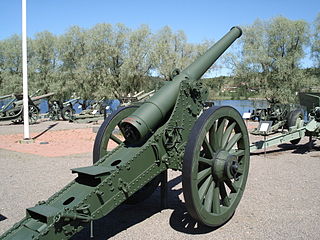
The Canon de 120 mm L modèle 1878 was a French piece of siege and field artillery which was widely used during the First World War and despite its obsolescence, it was still in use by some nations during the Second World War.
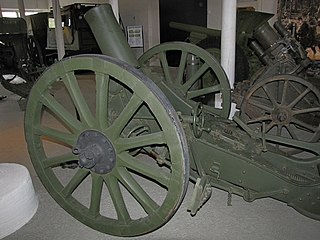
The 120 mm howitzerModel 1901 – was a German howitzer used by the Imperial Russian and Romanian Armies during the First World War.
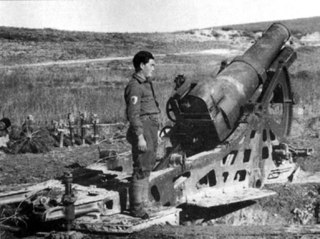
The Mortaio da 260/9 Modello 16 - was an Italian Heavy mortar and Siege Gun designed by the French Schneider Company and produced under license in Italy by Ansaldo and Vickers-Terni for the Italian Army. It was used by the Italian Army during both the First World War and Second World War.
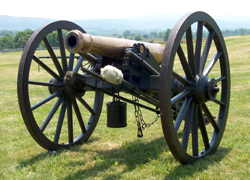
The M1841 6-pounder field gun was a bronze smoothbore muzzleloading cannon that was adopted by the United States Army in 1841 and used from the Mexican–American War to the American Civil War. It fired a 6.1 lb (2.8 kg) round shot up to a distance of 1,523 yd (1,393 m) at 5° elevation. It could also fire canister shot and spherical case shot (shrapnel). The cannon proved very effective when employed by light artillery units during the Mexican–American War. The cannon was used during the early years of the American Civil War, but it was soon outclassed by newer field guns such as the M1857 12-pounder Napoleon. In the U.S. Army, the 6-pounders were replaced as soon as more modern weapons became available and none were manufactured after 1862. However, the Confederate States Army continued to use the cannon for a longer period because the lesser industrial capacity of the South could not produce new guns as fast as the North.

The 10-pounder Parrott rifle, Model 1861 was a muzzle-loading rifled cannon made of cast iron that was adopted by the United States Army in 1861 and often used in field artillery units during the American Civil War. Like other Parrott rifles, the gun breech was reinforced by a distinctive band made of wrought iron. The 10-pounder Parrott rifle was capable of firing shell, shrapnel shell, canister shot, or solid shot. Midway through the war, the Federal government discontinued the 2.9 in (74 mm) version in favor of a 3.0 in (76 mm) version. Despite the reinforcing band, the guns occasionally burst without warning, which endangered the gun crews. The Confederate States of America manufactured a number of successful copies of the gun.

The M1841 24-pounder howitzer was a bronze smoothbore muzzle-loading artillery piece adopted by the United States Army in 1841 and employed from the Mexican–American War through the American Civil War. It fired a 18.4 lb (8.3 kg) shell to a distance of 1,322 yd (1,209 m) at 5° elevation. It could also fire canister shot and spherical case shot. The howitzer was designed to be employed in a mixed battery with 12-pounder field guns. By the time of the American Civil War, the 24-pounder howitzer was superseded by the 12-pounder Napoleon, which combined the functions of both field gun and howitzer. The 24-pounder howitzer's use as field artillery was limited during the conflict and production of the weapon in the North ended in 1863. The Confederate States of America manufactured a few 24-pounder howitzers and imported others from the Austrian Empire.
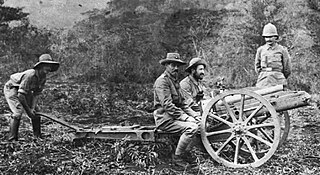
The 7.5 cm GebirgsKanone 13 or 7.5 cm GebK 13 was a mountain gun used by Germany and the Ottoman Empire during World War I.
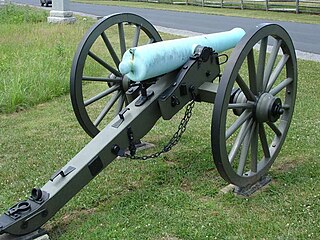
The M1857 12-pounder Napoleon or Light 12-pounder gun or 12-pounder gun-howitzer was a bronze smoothbore muzzle-loading artillery piece that was adopted by the United States Army in 1857 and extensively employed in the American Civil War. The gun was the American-manufactured version of the French canon obusier de 12 which combined the functions of both field gun and howitzer. The weapon proved to be simple to produce, reliable, and robust. It fired a 12.03 lb (5.5 kg) round shot a distance of 1,619 to 1,680 yd at 5° elevation. It could also fire canister shot, common shell, and spherical case shot. The 12-pounder Napoleon outclassed and soon replaced the M1841 6-pounder field gun and the M1841 12-pounder howitzer in the U.S. Army, while replacement of these older weapons was slower in the Confederate States Army. A total of 1,157 were produced for the U.S. Army, all but a few in the period 1861–1863. The Confederate States of America utilized captured U.S. 12-pounder Napoleons and also manufactured about 500 during the war. The weapon was named after Napoleon III of France, who helped develop the weapon.










